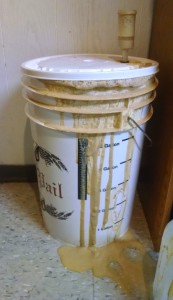My first starter homebrew kit came with the standard 3-piece airlock. It always served me well, was easy to use, so I had no reason to question it. But I made a couple of batches that made me realize the blow-off tube method of managing off-gassing has its place as well.
The first instance was a batch I made at a Big Brew Day event at a local brewery (Rochester Mills). As part of the event, they provided everyone with yeast slurry from the production facility. I provided a clean & sanitized growler and they filled it with yeast. After I made my beer and transferred it into the fermenting bucket, I went and retrieved my growler of yeast. It was almost completely full with thick yeast sludge/foam. I dumped the whole thing in there, and had no doubts of this beer’s ability to convert. It was truckloads more yeast than I’ve ever pitched before.
After fermenting for a day in the basement, I went down the next day to see a blowout disaster. The airlock had backed up and filled with yeast/krausen, the pressure built up, and eventually popped the lid off my fermenting bucket and puked mess out around on the bucket and floor.
basement, I went down the next day to see a blowout disaster. The airlock had backed up and filled with yeast/krausen, the pressure built up, and eventually popped the lid off my fermenting bucket and puked mess out around on the bucket and floor.
Thinking I had passed the worst of it, I cleaned things off, cleaned out the airlock and put it back on. Checking again a few hours later, I saw foam starting to creep into the airlock again. At that point I knew I couldn’t contain it, so I improvised and shoved a length of extra hose onto the body of the airlock and ran the hose down into a growler filled with water to keep the hose from being exposed to air. Soon I had giant glugs of air going out through the water. With the size of the hose, I didn’t have any risk of plugging up with foam.
and shoved a length of extra hose onto the body of the airlock and ran the hose down into a growler filled with water to keep the hose from being exposed to air. Soon I had giant glugs of air going out through the water. With the size of the hose, I didn’t have any risk of plugging up with foam.
The other instance I found the blow-off tube helpful at avoiding the blowout was a beer where I had my fermenting bucket really full. I was going to be doing a large amount of dry hops, and to counteract the lost volume from all the debris I’d get, I put 5.5 – 6 gallons of wort into my fermenting bucket. Once it started fermenting, I soon saw foam creeping down the tube. It made it all the way to the water jug, but still due to the size of the tube, never plugged and never had the over-pressurization issue. I’m sure if I had an airlock on there I would’ve plugged it and popped the top.
So the airlock has advantages of being simple. But if you’re going to have a really active fermentation, or a large volume in your fermenting bucket, you probably should do the blow-off tube.
